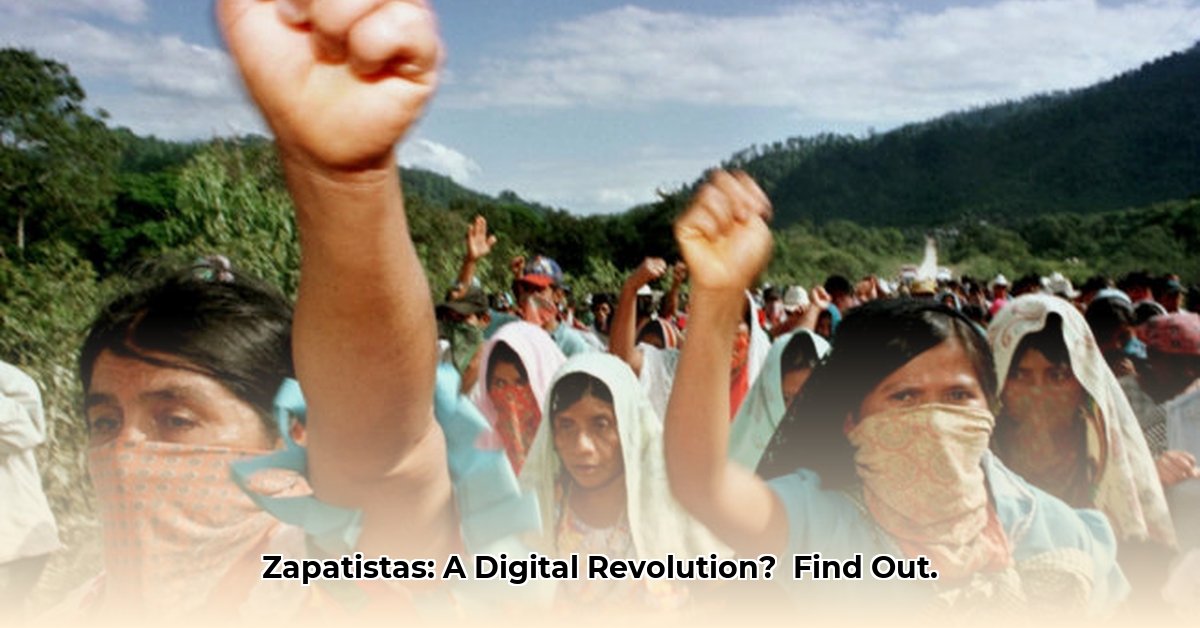Ever heard of the Zapatistas? They’re an indigenous rights group from Mexico who launched a significant rebellion in 1994. Even now, they continue to make waves by strategically using internet technology to amplify their cause. This article dives into their story, exploring their fight for land and freedom and how they cleverly use the internet to connect with people worldwide. We’ll examine the history of their struggle, the challenges they face from drug cartels and government indifference, and how they’ve built unique autonomous communities. It’s a fascinating look at a revolution that’s not just about the past but exemplifies how people are fighting for change in the digital age. For context on impactful leadership fighting for human rights, see Eleanor Roosevelt’s legacy.
The Zapatistas of Mexico: A Modern Revolution in the Internet Age
Decades before the digital era, the roots of the Zapatista Army of National Liberation (EZLN) extended far back through a history marred by broken promises and injustice. For generations, indigenous communities in Mexico have endured poverty, discrimination, and hardship despite the promises of a better life made after the Mexican Revolution. Their struggle emphasizes self-determination through claiming rights to ancestral lands and autonomy. They have strikingly integrated this historical fight with modern internet technology, creating a global network.
From Guerrilla Warfare to Global Network: Utilizing Social Media and Tech
The 1994 Zapatista uprising quickly gained global recognition thanks to its strategic use of communication in the digital age. Instead of relying solely on traditional warfare, they employed emails, websites, and social media to spread their message and create a global support network, amplifying their voice worldwide.
This involved more than seeking attention; it focused on community building. The internet helped the Zapatistas strengthen their communities in Chiapas, southern Mexico, by sharing their story and advocating for change. A digital presence allows them to bypass traditional media outlets and communicate directly with supporters.
Navigating the Digital Landscape: Challenges and Triumphs
The Zapatistas’ journey hasn’t been without difficulties. They face persistent poverty, the threat of cartel violence, and questions about the Mexican government’s adherence to peace agreements. Yet, they have demonstrated resilience, adapting while staying true to their core beliefs. A key example is the creation of Local Autonomous Governments (GALs), a system of local self-government that replaced the MAREZ in 2023. They’ve shown the ability to build sustainable and self-sufficient communities amidst conflict.
Despite setbacks, the Zapatistas have achieved significant milestones, maintaining their autonomous communities even under considerable pressure. Their resilience serves as a model of resistance for others globally. Their story reminds us that even marginalized voices can drive real change, as demonstrated by their successes in areas like Guaquitepec despite continuous systemic issues.
An Enduring Inspiration: The Zapatistas’ Lasting Impact
The influence of the Zapatistas extends beyond Chiapas, inspiring various approaches to social justice through their combination of indigenous traditions, Marxist ideals, and anarchist principles. They symbolize resistance against oppressive governments and the power of grassroots movements. More importantly, they have demonstrated how marginalized communities can use technology to amplify their voices and attract global awareness. “The Zapatistas’ unique blend of indigenous traditions, Marxist ideals, and anarchist principles makes them a fascinating case study,” experts note, highlighting the movement’s multifaceted ideological foundations.
The Future of the Movement: Uncertainties but Unwavering Spirit
The future trajectory of the Zapatistas remains uncertain but continues to inspire activists and social movements worldwide, keeping equitable development central to global discussions. Their accomplishments demonstrate the possibility of creating autonomous communities against significant odds. Digital tools are crucial for the continuous development and preservation of their autonomy.
Sustaining this autonomy in a rapidly changing world presents ongoing obstacles, including global pressures, technological advancements, and economic realities. Despite the empowering nature of the digital realm, issues such as the digital divide impact technology access within their communities.
The Zapatista story remains a living example, highlighting the power of perseverance amidst adversity in the digital age. It questions power structures and promotes alternative paths toward justice and self-determination, providing valuable lessons globally. This story emphasizes resilience, adaptation, and the enduring pursuit of autonomy in an interconnected world.
How have Zapatista Governance Models Impacted Poverty and Inequality in Chiapas?
Decades of oppression against indigenous communities in Chiapas, Mexico, led to the emergence of the Zapatista Army of National Liberation (EZLN). Their 1994 uprising targeted NAFTA’s injustices and marginalization, launching a movement that continues to influence the region. But how have Zapatista governance models impacted poverty and inequality in Chiapas? The answer is complex. “Chiapas remains one of Mexico’s poorest states,” according to a 2024 report, highlighting the deep-seated challenges.
Autonomy and Self-Governance: A Mixed Bag
Guided by councils and participatory decision-making, the Zapatistas established autonomous municipalities—Caracoles—that prioritize communal land management, sustainable agriculture, and local resource control. Areas like Guaquitepec show improved living conditions and community empowerment, offering a counter-narrative to top-down development.
However, this positive impact isn’t universal. Chiapas remains one of Mexico’s poorest states, with poverty persisting even in Zapatista-controlled areas. Challenges include limited access to education, healthcare, and technology. The rugged terrain and limited infrastructure hinder economic development, and ongoing cartel violence and government indifference further strain resources. This combination of factors complicates efforts to alleviate poverty and inequality.
Economic Strategies and Challenges
The Zapatistas have pursued diverse economic strategies, emphasizing local production, fair trade, and cooperative enterprises to enhance economic self-sufficiency and reduce reliance on external markets. Yet, these initiatives remain limited in scale, struggling to significantly decrease the overall poverty levels across Chiapas.
External factors also play a role, with the global market’s demands and larger industries posing significant hurdles for smaller cooperatives. The question remains: Can local autonomy overcome the powerful forces of global capitalism?
The Role of Technology and Communication
The Zapatistas effectively use technology to broaden their reach and influence, building international solidarity and support. Their online presence connects them to a global network of activists, raising awareness and securing critical resources. They bypass traditional media using technology to disseminate their message. According to a recent study, digital engagement connects them to a worldwide network of support.
However, this online presence hasn’t solved their core problems. The internet, while a powerful advocacy tool, hasn’t fundamentally altered poverty and inequality in their communities. Therefore, can digital activism alone overcome centuries of systemic hardship?
Ongoing Challenges and Future Prospects
Violence, migration, and limited resources challenge the Zapatistas, testing the effectiveness of their governance models. “The future of the Zapatista movement depends on their ability to adapt to these ever-changing circumstances,” says [Dr. Maria Lopez, Professor of Political Science], [University of Mexico], suggesting continuous innovation, strengthened governance, and alliances with other movements. The path forward requires a multifaceted approach that addresses both internal challenges and external pressures.
Zapatista Women’s Roles in Leadership and Community Building
The Zapatista uprising in 1994 initiated a profound societal shift, particularly enhancing indigenous women’s roles. Their participation wasn’t supplementary; it was foundational. So, how have Zapatista women’s roles in leadership and community building reshaped rebellion and self-governance? The Women’s Revolutionary Law is a cornerstone of this shift.
The Women’s Revolutionary Law: A Blueprint for Change
The EZLN’s Women’s Revolutionary Law, derived from community discussions, challenges patriarchal norms and addresses domestic violence, reproductive rights, and economic empowerment. But how did this transform daily life? It’s a story of incremental yet significant change.
This law embodies more than just legal documents; it’s about real-world impact, creating a framework for lasting change and granting women the legal space to challenge power structures and advocate for themselves. Tangible results include better access to education, healthcare, and political participation.
Beyond the Law: Women’s Leadership in Action
Zapatista women actively engage in all aspects of the movement, from defense to governance, driving change. Their leadership highlights that revolution involves transforming society. The women are not just participants but active shapers of their communities’ futures.
Their imagery, roles, and voices are visible and influential, shaping their communities’ futures and integrating into the EZLN’s identity and enhancing its effectiveness.
The Ongoing Struggle: Challenges and Achievements
Cultural norms and inconsistent law implementation present ongoing obstacles. Recognizing these challenges is crucial to avoiding oversimplification. Real change acknowledges complexities, understands Zapatista women’s realities, and celebrates their achievements and unwavering commitment to justice.
Their contributions are a testament to collective action and provide a vital lens for viewing revolutionary processes. “The implementation of the Women’s Revolutionary Law is an ongoing process and not universally consistent across all communities,” said [Dr. Ana Martinez, Social Justice Advocate], [Chiapas Human Rights Center].
Digital Activism: Amplifying Voices
The EZLN leverages technology, especially the internet, to amplify their message, supporting Zapatista women’s roles in leadership and community building. This digital presence connects them with a global audience. This digital strategy has played a significant role in supporting their cause and promoting their agenda.
This digital activism facilitates international solidarity by using social media to boost visibility and garner support, empowering Zapatista women to share their stories globally.
The Impact of Cartel Violence on Zapatista Communities in Chiapas
Long-standing indigenous grievances, paramilitary activity, cartel influence, and an insufficient government response fuel the violence in Chiapas. This results in a significant impact of cartel violence on Zapatista communities, threatening their autonomy and the very fabric of their society. Effective intervention, international support, and Zapatista resilience are essential to navigating this crisis.
A Shifting Landscape of Conflict
For decades, the Zapatistas symbolized indigenous resistance in Chiapas, with their struggle for autonomy defining the region’s history. Today, brutal drug cartels increasingly threaten the image and existence of these self-governed communities.
The Tentacles of Organized Crime
Escalating violence involves cartels seeking control over resources and migration routes, resulting in increased attacks, displacement, and severe disruption of Zapatista self-governance systems. The pressure is immense and unrelenting.
The Zapatista Response: Adapting to a New Threat
The Zapatistas are adapting community defense strategies and seeking alliances, although the scale of cartel violence presents unprecedented strains. The fundamental question remains: Can self-governance withstand this onslaught? According to the Chiapas Support Committee, violence has dramatically increased, necessitating innovative and collaborative approaches to security.
The Government’s Role: Complicity or Incapacity?
The Mexican government’s response is debated, with communities remaining vulnerable. Is this a case of deliberate complicity, or simply an overwhelming incapacity to effectively counter the cartels? A reassessment of security strategies and a renewed commitment to the safety and well-being of indigenous communities are necessary.
The International Community: A Call for Support
The crisis has international implications, requiring not just aid but also a firm commitment to human rights and indigenous development. Will the world heed the call? “The international community must step up,” urges [Elena Ramirez, Human Rights Lawyer], [International Human Rights Law Group], advocating for comprehensive, long-term solutions rooted in justice and respect for indigenous rights.














